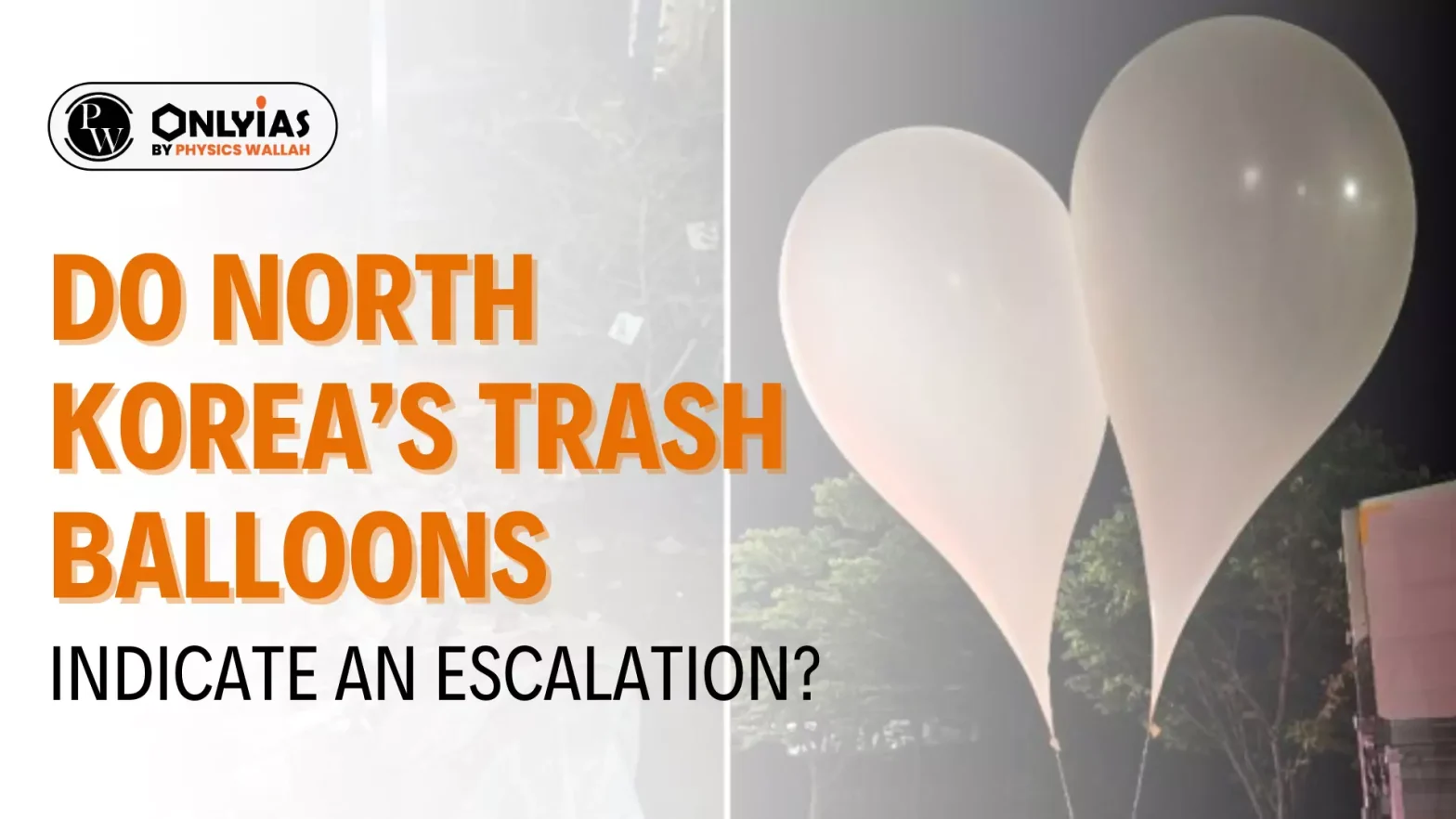South Korea has suspended a 2018 peace agreement and said it might resume propaganda broadcasts into the North after Pyongyang sent thousands of balloons carrying trash and human waste into the South.
| Relevancy for Prelims: Map of Korean Peninsula, 2018 Peace Agreement, Sea of Japan.
Relevancy for Mains: Tensions between North Korea and South Korea, Implications of North-South Korea Tensions over Regional Security Dynamics in Asia. |
South Korea’s Response to North Korea’s Provocations
- Warning and Planned Countermeasures: The South Korean government has warned of planning countermeasures against North Korea.
- Provocations escalated after North Korea’s failed attempt to place a spy satellite into orbit on May 27.
- Emergency Meeting: South Korea’s ruling People Power Party (PPP) convened an emergency committee meeting focused on responses to North Korea’s actions after the rocket carrying the satellite exploded midair shortly after launch.
- North Korea’s Provocative Actions:
- GPS Signal Jamming: Since late May, North Korea has jammed GPS signals over a wide area off the west coast of the Korean Peninsula. This potentially endangers civilian air and maritime traffic.
- Ballistic Missiles and Rocket Launchers: North Korea fired 10 short-range ballistic missiles into the Sea of Japan. Rounds were also fired from 18 multiple rocket launchers into the Sea of Japan.
- Threats and Balloon Launches: Pyongyang issued threats against shipping near the disputed sea border off the west coast. Claimed to have released 2,000 balloons carrying trash and human waste over the border into the South.
- Impact in South Korea: Authorities confirmed around 700 balloons landed in the South. This caused minor damage and spread human feces and rubbish at landing sites.
- Statements and Decisions: Senior PPP official stated that North Korea would “inevitably pay the price” for the provocations and demanded an immediate apology from Pyongyang.
- The government decided to fully suspend the 2018 inter-Korean peace pact until mutual trust is restored between the two Koreas.
Enroll now for UPSC Online Course
South Korea’s Consideration of Propaganda Broadcasts
- Possible Resumption of Propaganda Broadcasts: Seoul may resume propaganda broadcasts into North Korea from large loudspeakers near the Demilitarized Zone.
- The broadcasts were turned off in 2018 but their resumption would be seen as an escalation, as they are considered psychological warfare.
- North Korea has previously threatened to target the speaker sites with artillery.
- North Korea’s Reaction: North Korea indicated they would stop sending balloons if the South refrained from resuming the broadcasts.
- This suggests a temporary relief in tensions, although further developments are anticipated.
- Potential Military Implications: Current tensions might indicate Kim Jong Un is making a significant military push. There is a widespread belief that Kim is aiming to develop weapons capable of striking the continental United States.
- It is believed that Kim is receiving assistance from Russia in developing such weapons.
North Korea Emboldened by Russian Support
- Russian Assistance and Arms Exchange: The US warns that Russia is aiding North Korea in developing advanced weapons technology, including hypersonic missiles.
- In exchange, North Korea provides artillery shells to Russia for its ongoing war in Ukraine.
- Increased Boldness Against International Criticism: With Russia’s backing as a UN Security Council permanent member, Pyongyang feels more emboldened.
- After UN Secretary-General Antonio Guterres condemned North Korea’s failed satellite launch, North Korea retaliated by calling Guterres a “servant” of the US.
- UN Security Council Dynamics: Proposals for a new UN Security Council resolution on North Korea were abandoned due to anticipated Russian vetoes. Security Council is currently paralyzed on such issues, allowing North Korea to act with impunity.
- Implications of Russian Support: Russia’s support has eroded political and diplomatic pressure on Pyongyang. Russia has effectively given North Korea the green light to pursue its objectives without fear of international consequences.
Check Out UPSC Modules From PW Store
Escalated Danger of Conflict?
- Explicit Backing of Moscow: Kim Jong Un has the explicit support of Moscow, deviating from the policies of his father and grandfather regarding South Korea.
- Shift in North Korean Policy: Kim’s predecessors aimed to outperform the South after failing to win the Korean War. This policy seems to be shifted earlier this year.
- Possible Motivations for Aggression: Kim may be acting aggressively due to dissatisfaction with the current situation or the long-standing status quo.
- He might seek to overturn the status quo through alternative strategies, potentially including military force.
- Comparison with Other Nations: Kim’s approach aligns with the policies of China, Russia, and Iran, which use force to challenge the US-led liberal world order.
- These countries do not prioritize human rights, open economies, or peaceful dispute settlements, viewing force as a legitimate foreign policy tool.
- Need for Vigilance: Despite the familiar nature of North Korean provocations, the South and its allies must remain vigilant.
- North Korea’s use of balloons filled with trash serves to test South Korea’s air defenses and probe for weaknesses.
- Military Implications: The balloons, while appearing emotionally immature, have strategic uses. They allow North Korea to assess the speed and effectiveness of South Korea’s military responses and identify gaps in radar coverage.
Conclusion
North Korea’s increasing provocations, backed by Russian support, necessitate vigilant and strategic responses from South Korea to maintain stability and counter potential military threats.
Enroll now for UPSC Online Classes
![]() 6 Jun 2024
6 Jun 2024

